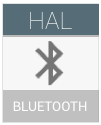
Android cung cấp một ngăn xếp Bluetooth mặc định hỗ trợ cả Bluetooth cổ điển và Bluetooth năng lượng thấp (BLE). Bằng Bluetooth, các thiết bị Android có thể tạo mạng khu vực cá nhân để gửi và nhận dữ liệu với các thiết bị Bluetooth ở gần.
Trong Android 4.3 trở lên, ngăn xếp Bluetooth của Android cung cấp khả năng triển khai BLE. Để sử dụng đầy đủ các API BLE, hãy tuân thủ Các yêu cầu về HCI Bluetooth của Android. Các thiết bị Android có một bộ vi mạch đủ tiêu chuẩn có thể triển khai Bluetooth truyền thống hoặc cả Bluetooth truyền thống và BLE. BLE không tương thích ngược với các chipset Bluetooth cũ.
Trong Android 8.0, ngăn xếp Bluetooth hoàn toàn đủ điều kiện cho Bluetooth 5. Để sử dụng các tính năng Bluetooth 5 hiện có, thiết bị cần có một chipset đủ tiêu chuẩn Bluetooth 5.
Cấu trúc Android
Ứng dụng Bluetooth giao tiếp với quy trình Bluetooth thông qua Binder. Quy trình Bluetooth sử dụng Giao diện gốc Java (JNI) để giao tiếp với ngăn xếp Bluetooth và cho phép nhà phát triển truy cập vào nhiều hồ sơ Bluetooth. Sơ đồ này cho thấy cấu trúc chung của ngăn xếp Bluetooth:

Hình 1. Cấu trúc Bluetooth của Android.
- khung ứng dụng
- Ở cấp khung ứng dụng là mã ứng dụng, sử dụng các API
android.bluetoothđể tương tác với phần cứng Bluetooth. Trong nội bộ, mã này sẽ gọi quy trình Bluetooth thông qua cơ chế Binder IPC. - Ứng dụng Bluetooth
- Ứng dụng Bluetooth nằm trong
packages/modules/Bluetooth/android/app, được đóng gói dưới dạng một ứng dụng Android và triển khai các hồ sơ Bluetooth ở lớp khung Android. Ứng dụng này gọi vào ngăn xếp Bluetooth thông qua JNI. - JNI
- Mã JNI liên kết với
android.bluetoothnằm trongpackages/modules/Bluetooth/android/app/jni. Mã JNI gọi vào ngăn xếp Bluetooth khi một số thao tác Bluetooth xảy ra, chẳng hạn như khi các thiết bị được phát hiện. - Ngăn xếp Bluetooth
- Ngăn xếp Bluetooth mặc định được cung cấp trong AOSP và nằm trong
packages/modules/Bluetooth/system. Ngăn xếp này triển khai HAL Bluetooth chung và tuỳ chỉnh HAL đó bằng các tiện ích và thay đổi về cấu hình. - triển khai nhà cung cấp
- Các thiết bị của nhà cung cấp tương tác với ngăn xếp Bluetooth bằng ngôn ngữ định nghĩa giao diện HAL (HIDL).
HIDL
HIDL xác định giao diện giữa ngăn xếp Bluetooth và quá trình triển khai của nhà cung cấp. Để tạo các tệp HIDL Bluetooth, hãy truyền các tệp giao diện Bluetooth vào công cụ tạo HIDL. Các tệp giao diện nằm trong hardware/interfaces/bluetooth.
Phát triển ngăn xếp Bluetooth
Ngăn xếp Bluetooth Android là một ngăn xếp Bluetooth đủ điều kiện. Danh sách đủ điều kiện có trên trang web của Bluetooth SIG (bạn phải đăng nhập) trong phần QDID 169365.
Ngăn xếp Bluetooth cốt lõi nằm trong packages/modules/Bluetooth.
Quá trình phát triển diễn ra trong AOSP và chúng tôi hoan nghênh mọi đóng góp.

